Abstract
Tubulin, purified by cycles of assembly followed by phosphocellulose chromatography, exhibits a characteristic GTPase activity that is polymerization dependent and can be attributed to the tubulin itself. This activity has been observed, in a standard reassembly buffer containing low Mg2+, under three conditions that induce microtubule assembly: in the presence of microtubule-associated proteins, in the presence of DEAE-dextran, or after addition of high Mg2+ and glycerol. The phosphocellulose-purified tubulin showed no GTPase activity under the following nonpolymerizing conditions: in buffer with low Mg2+ in the absence of microtubule-associated proteins or DEAE-dextran, in buffer with high Mg2+ and glycerol at tubulin concentrations below the critical concentration, or when microtubule assembly was inhibited by vinblastine. Colchicine, on the other hand, while blocking microtubule assembly, induced a significant GTPase activity in the phosphocellulose-purified tubulin. During the process of assembly, GTP appears to be hydrolyzed as a free tubulin dimer polymerizes into a microtubule. A constant GTPase activity when polymerization equilibrium is reached apparently reflects the cyclic polymerization-depolymerization of tubulin dimers at the ends of the microtubules.
Full text
PDF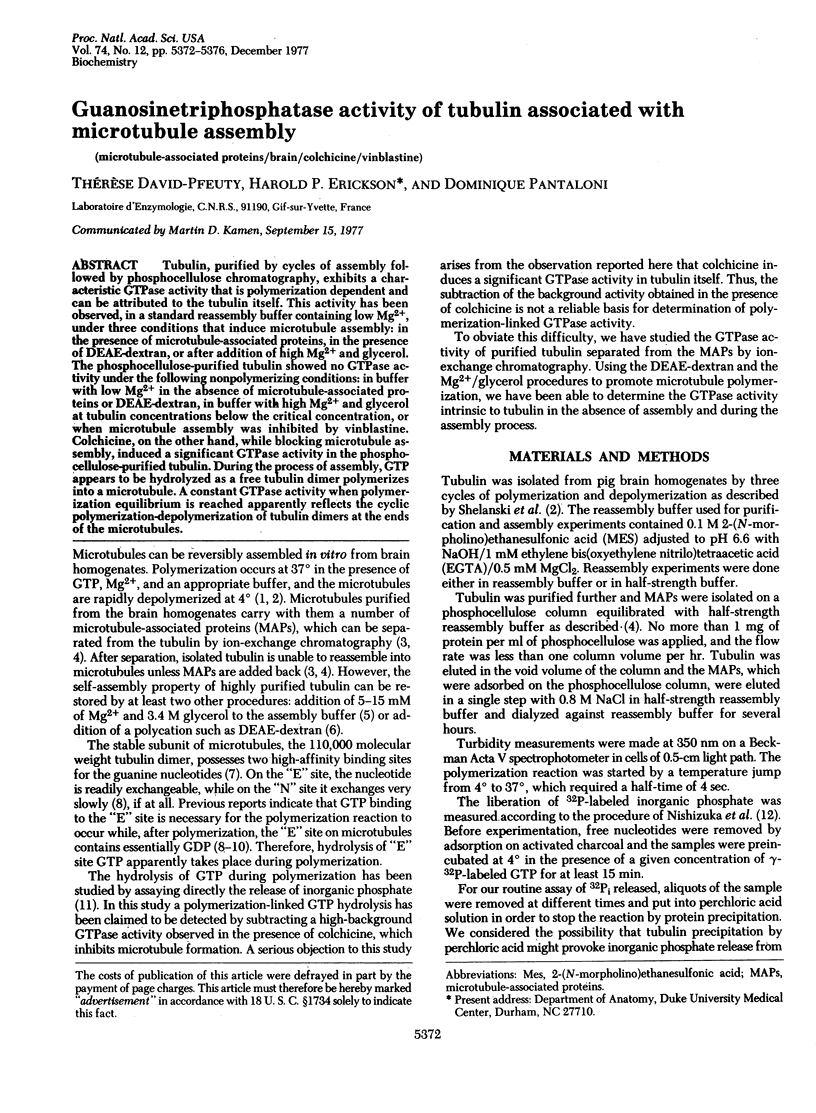
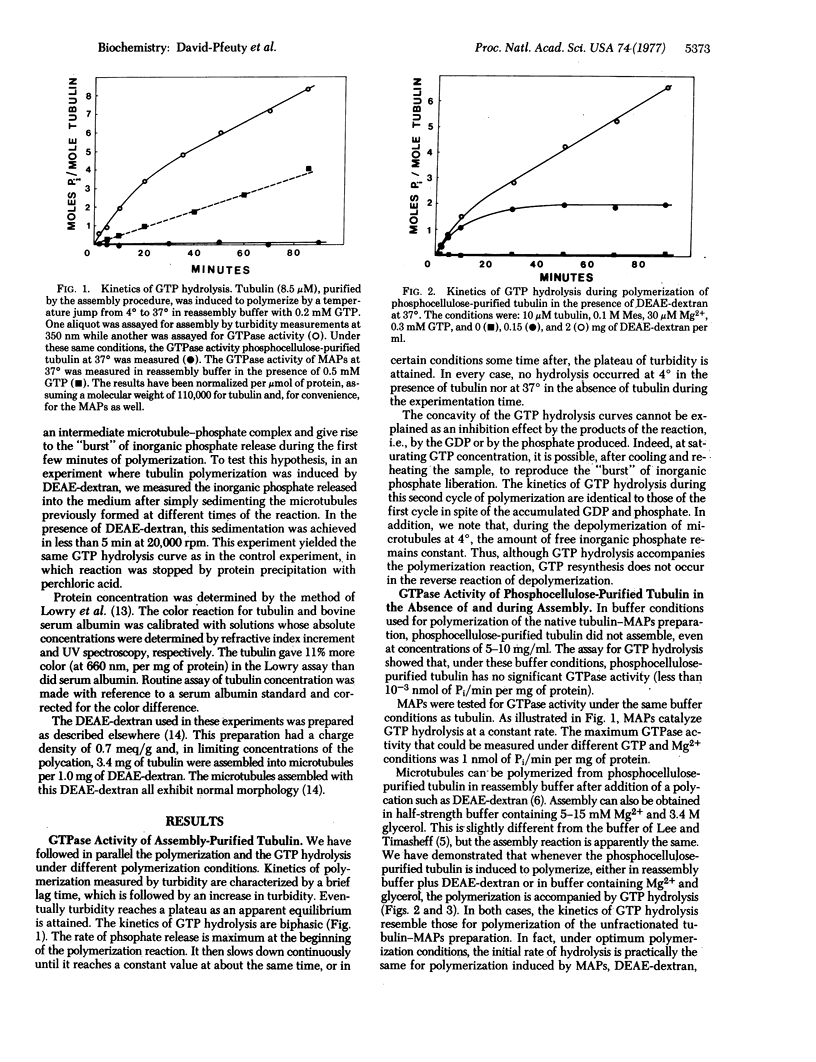
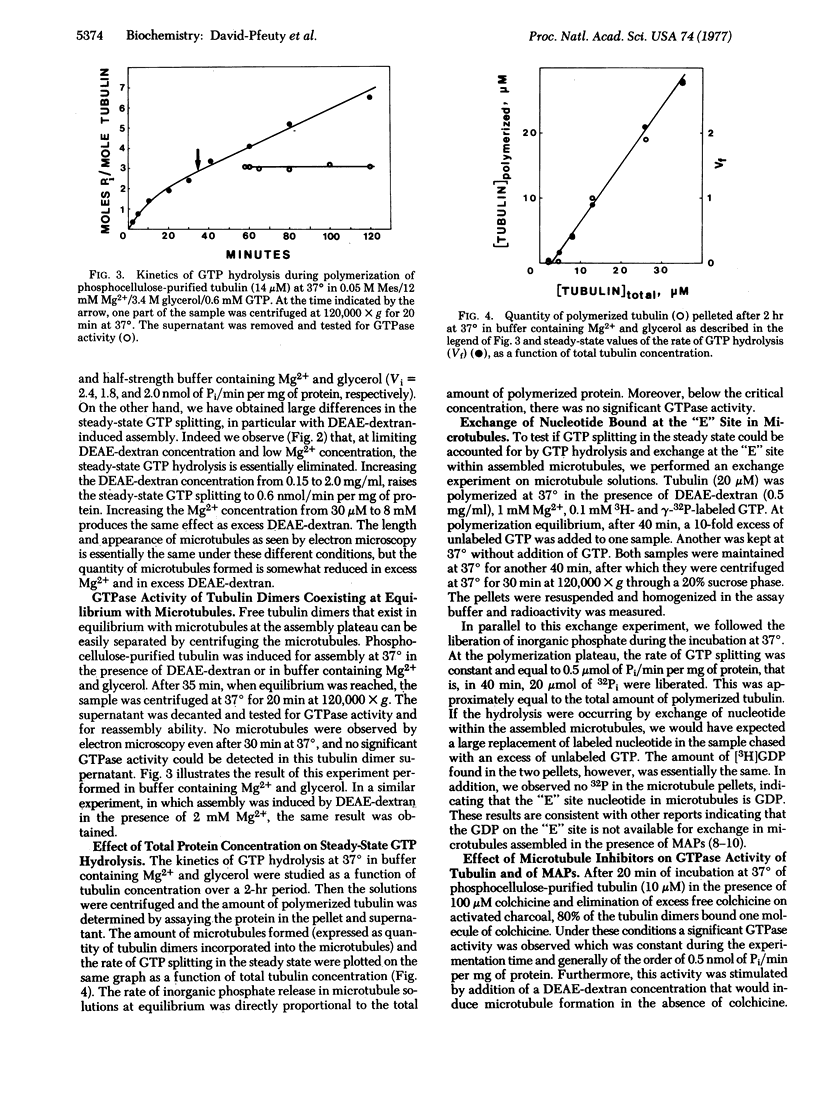
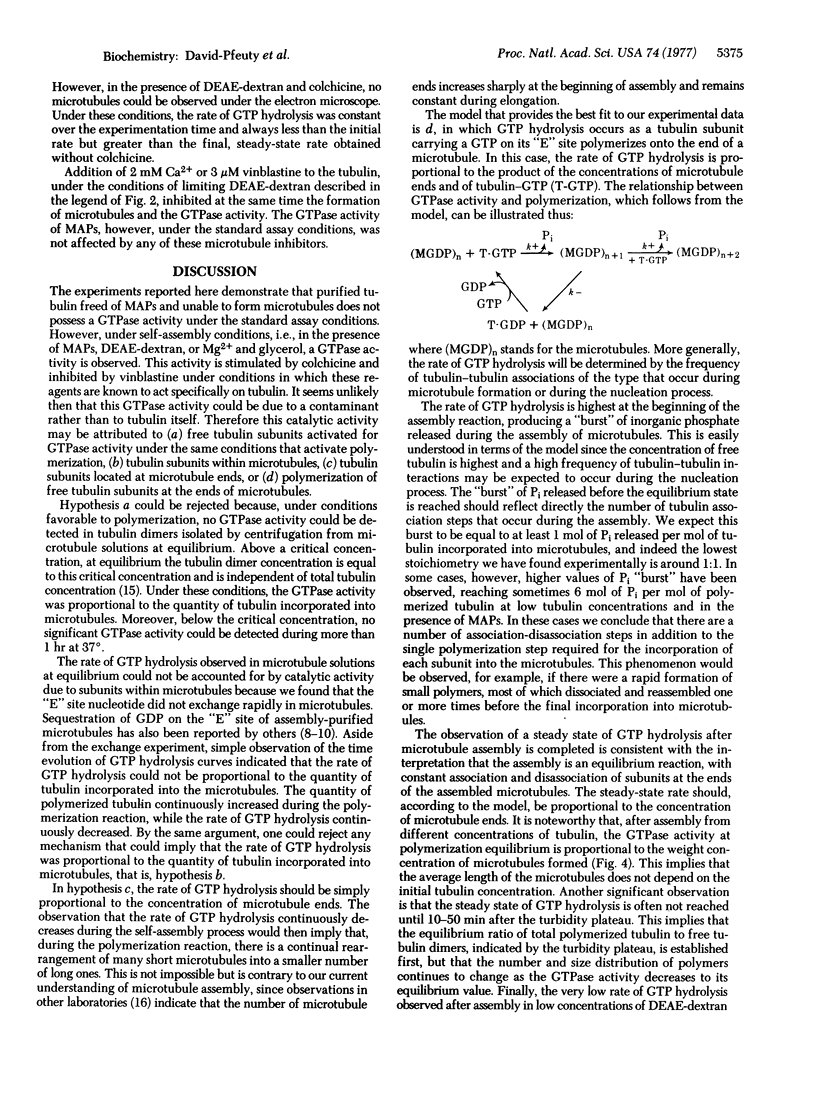
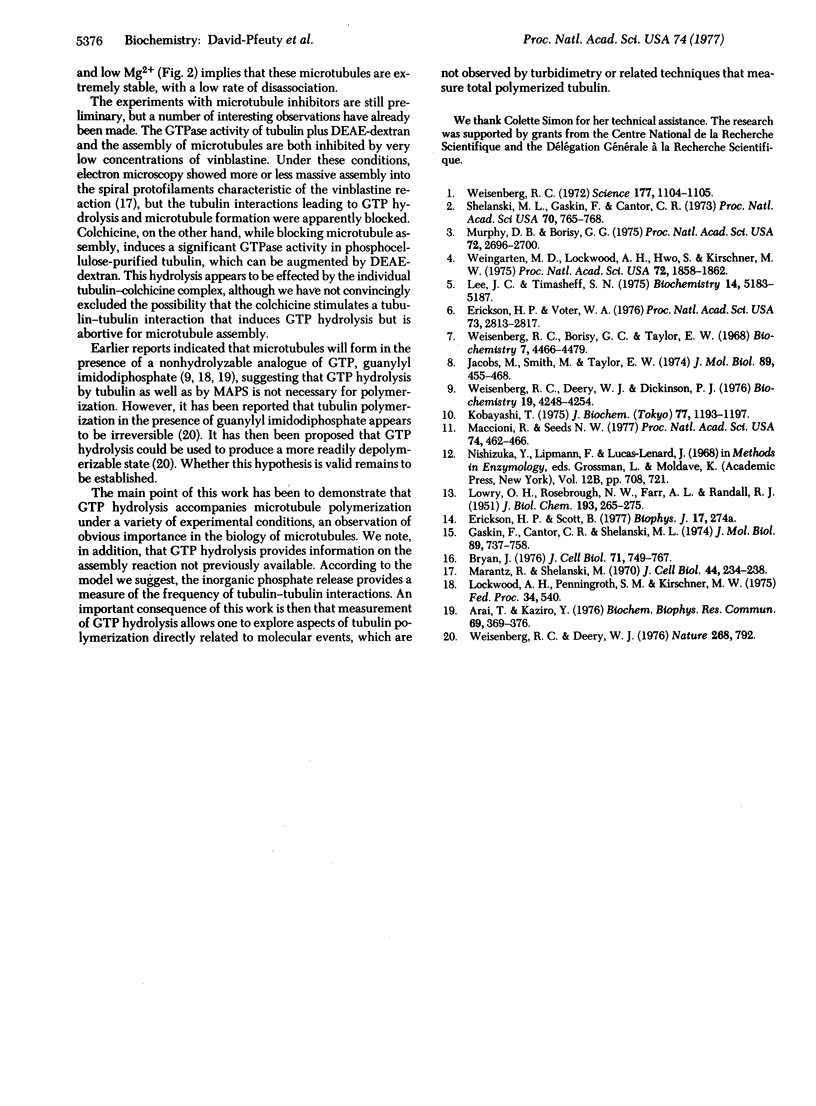
Selected References
These references are in PubMed. This may not be the complete list of references from this article.
- Arai T., Kaziro Y. Effect of guanine nucleotides on the assembly of brain microtubles: ability of 5'-guanylyl imidodiphosphate to replace GTB in promoting the polymerization of microtubules in vitro. Biochem Biophys Res Commun. 1976 Mar 22;69(2):369–376. doi: 10.1016/0006-291x(76)90531-3. [DOI] [PubMed] [Google Scholar]
- Bryan J. A quantitative analysis of microtubule elongation. J Cell Biol. 1976 Dec;71(3):749–767. doi: 10.1083/jcb.71.3.749. [DOI] [PMC free article] [PubMed] [Google Scholar]
- Erickson H. P., Voter W. A. Polycation-induced assembly of purified tubulin. Proc Natl Acad Sci U S A. 1976 Aug;73(8):2813–2817. doi: 10.1073/pnas.73.8.2813. [DOI] [PMC free article] [PubMed] [Google Scholar]
- Gaskin F., Cantor C. R., Shelanski M. L. Turbidimetric studies of the in vitro assembly and disassembly of porcine neurotubules. J Mol Biol. 1974 Nov 15;89(4):737–755. doi: 10.1016/0022-2836(74)90048-5. [DOI] [PubMed] [Google Scholar]
- Jacobs M., Smith H., Taylor E. W. Tublin: nucleotide binding and enzymic activity. J Mol Biol. 1974 Nov 5;89(3):455–468. doi: 10.1016/0022-2836(74)90475-6. [DOI] [PubMed] [Google Scholar]
- Kobayashi T. Dephosphorylation of tubulin-bound guanosine triphosphate during microtubule assembly. J Biochem. 1975 Jun;77(6):1193–1197. [PubMed] [Google Scholar]
- LOWRY O. H., ROSEBROUGH N. J., FARR A. L., RANDALL R. J. Protein measurement with the Folin phenol reagent. J Biol Chem. 1951 Nov;193(1):265–275. [PubMed] [Google Scholar]
- Lee J. C., Timasheff S. N. The reconstitution of microtubules from purified calf brain tubulin. Biochemistry. 1975 Nov 18;14(23):5183–5187. doi: 10.1021/bi00694a025. [DOI] [PubMed] [Google Scholar]
- Maccioni R., Seeds N. W. Stoichiometry of GTP hydrolysis and tubulin polymerization. Proc Natl Acad Sci U S A. 1977 Feb;74(2):462–466. doi: 10.1073/pnas.74.2.462. [DOI] [PMC free article] [PubMed] [Google Scholar]
- Marantz R., Shelanski M. L. Structure of microtubular crystals induced by vinblastine in vitro. J Cell Biol. 1970 Jan;44(1):234–238. doi: 10.1083/jcb.44.1.234. [DOI] [PMC free article] [PubMed] [Google Scholar]
- Murphy D. B., Borisy G. G. Association of high-molecular-weight proteins with microtubules and their role in microtubule assembly in vitro. Proc Natl Acad Sci U S A. 1975 Jul;72(7):2696–2700. doi: 10.1073/pnas.72.7.2696. [DOI] [PMC free article] [PubMed] [Google Scholar]
- Shelanski M. L., Gaskin F., Cantor C. R. Microtubule assembly in the absence of added nucleotides. Proc Natl Acad Sci U S A. 1973 Mar;70(3):765–768. doi: 10.1073/pnas.70.3.765. [DOI] [PMC free article] [PubMed] [Google Scholar]
- Weingarten M. D., Lockwood A. H., Hwo S. Y., Kirschner M. W. A protein factor essential for microtubule assembly. Proc Natl Acad Sci U S A. 1975 May;72(5):1858–1862. doi: 10.1073/pnas.72.5.1858. [DOI] [PMC free article] [PubMed] [Google Scholar]
- Weisenberg R. C., Borisy G. G., Taylor E. W. The colchicine-binding protein of mammalian brain and its relation to microtubules. Biochemistry. 1968 Dec;7(12):4466–4479. doi: 10.1021/bi00852a043. [DOI] [PubMed] [Google Scholar]
- Weisenberg R. C., Deery W. J., Dickinson P. J. Tubulin-nucleotide interactions during the polymerization and depolymerization of microtubules. Biochemistry. 1976 Sep 21;15(19):4248–4254. doi: 10.1021/bi00664a018. [DOI] [PubMed] [Google Scholar]
- Weisenberg R. C., Deery W. J. Role of nucleotide hydrolysis in microtubule assembly. Nature. 1976 Oct 28;263(5580):792–793. doi: 10.1038/263792a0. [DOI] [PubMed] [Google Scholar]
- Weisenberg R. C. Microtubule formation in vitro in solutions containing low calcium concentrations. Science. 1972 Sep 22;177(4054):1104–1105. doi: 10.1126/science.177.4054.1104. [DOI] [PubMed] [Google Scholar]


